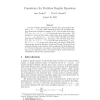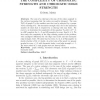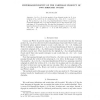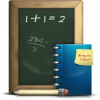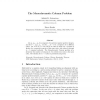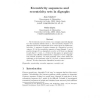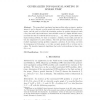DM
2006
14 years 6 months ago
2006
It is easy to deduce from Ramsey's Theorem that, given positive integers a1, a2, . . . , am and a finite colouring of the set N of positive integers, there exists an injectiv...
CC
2006
Springer
14 years 6 months ago
2006
Springer
The sum of a coloring is the sum of the colors assigned to the vertices (assuming that the colors are positive integers). The sum (G) of graph G is the smallest sum that can be ach...
ARSCOM
2006
14 years 6 months ago
2006
Let Za
EJC
2008
14 years 6 months ago
2008
Let D be a set of positive integers. The distance graph generated by D, denoted by G(Z, D), has the set Z of all integers as the vertex Supported in part by the National Science ...
DM
2008
14 years 6 months ago
2008
The chromatic capacity cap(G) of a graph G is the largest k for which there exists a k-coloring of the edges of G such that, for every coloring of the vertices of G with the same ...
DM
2008
14 years 6 months ago
2008
Let p1, p2,..., pn be a sequence of n pairwise coprime positive integers, and let P = p1p2...pn. Let 0, 1, ...,m - 1 be a sequence of m different colors. Let A be an n
ARSCOM
2008
14 years 6 months ago
2008
The eccentricity e(v) of a vertex v in a strongly connected digraph G is the maximum distance from v. The eccentricity sequence of a digraph is the list of eccentricities of its v...
FCT
1993
Springer
14 years 10 months ago
1993
Springer
The generalized topological sorting problem takes as input a positive integer k and a directed, acyclic graph with some vertices labeled by positive integers, and the goal is to la...
SPAA
2003
ACM
14 years 11 months ago
2003
ACM
This paper proves that for every positive integers n and k, we can explicitly construct a graph G with n+O(k) vertices and maximum degree 3, such that even after removing any k ve...
ICCS
2005
Springer
14 years 12 months ago
2005
Springer
Given a sequence A of numbers and two positive integers and k, we study the problem to find k disjoint segments of A, each has length at least , such that their sum of densities i...
